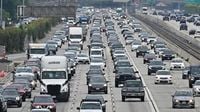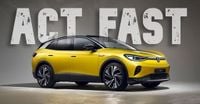In a significant move aimed at reshaping the U.S. automotive landscape, President Donald Trump announced last week that his administration will impose a 25% tariff on all cars, trucks, and automotive parts imported into the country, effective April 2, 2025. This policy is part of Trump's broader strategy to spur domestic manufacturing and reduce reliance on foreign imports.
As the tariffs loom, electric vehicles (EVs) are expected to be among the hardest hit. With rising consumer interest in EVs, potential buyers are urged to act quickly before prices rise. The tariffs will not retroactively impact vehicles already on dealer lots, but many dealers are already advertising “pre-tariff deals” to entice buyers. For instance, Chicago-area dealers are promoting discounts on new cars ahead of the tariff implementation.
The tariffs specifically target several popular EV models. Audi’s e-tron lineup, which includes vehicles like the Q4 and the RS e-Tron GT Quattro, is produced in Germany and currently offers various promotional deals, such as Costco cash and subsidized financing options. However, these deals may vanish once the tariffs take effect.
Similarly, the BMW iX, which topped J.D. Power’s EV satisfaction survey, is also manufactured in Germany. With its strong dealer support, the iX is another model that consumers might want to consider before the tariffs increase its price further.
Jeep's Wagoneer S, manufactured at Stellantis’ Toluca Assembly Plant in Mexico, is poised for a price hike as well. This 600 hp EV, with nearly 300 miles of EPA-rated range, is currently available with 0% financing for up to 72 months and a $3,000 bonus cash allowance for purchases made before March 31, 2025.
Polestar, designed in Sweden and manufactured in China, is another brand that could face challenges. The company is offering up to $20,000 in Tesla Conquest Cash to attract Tesla owners looking to switch to a Polestar 2. However, with tariffs on the horizon, this incentive may not last long.
Moreover, Toyota's bZ4X, despite having a U.S. battery plant, is manufactured in Japan, making it susceptible to tariffs. This model is currently being offered with significant discounts as part of Toyota’s efforts to boost sales.
Volkswagen’s ID.Buzz electric van, built in Hanover, Germany, is also expected to see increased prices due to the tariffs. With the ID.Buzz already criticized for its high price, potential buyers may want to act quickly before the tariffs further inflate costs.
While the tariffs aim to promote domestic production, defining what constitutes an American-made vehicle is complex. For example, Honda's Acura ADX is assembled in Mexico but has 30% of its parts originating from the U.S. or Canada. Conversely, the Cadillac CT4, assembled in the U.S., has only 15% of its parts sourced domestically, with a significant portion coming from Mexico.
Data from the National Highway Traffic Safety Administration (NHTSA) indicates that out of approximately 500 carlines, all had at least 20% of their components imported from outside the U.S. and Canada. Cars.com reports that just over half of new inventory vehicles have their final assembly in the U.S., while 19% are assembled in Mexico, 4.2% in Canada, and 1.4% in China.
According to Bank of America research analyst John Murphy, automakers that import a higher percentage of their vehicles will feel the brunt of these tariffs. General Motors, which imports 49% of its vehicles, along with Toyota, Hyundai, and Nissan, which import more than 50%, are particularly vulnerable. In contrast, Ford, which imports only about 20% of its total volume, may fare better.
Even Tesla, which manufactures its vehicles in the U.S., relies on imported parts for 25% to 40% of its components. This reliance means that even American manufacturers will not be entirely shielded from the impact of the tariffs.
The potential consequences of these tariffs extend beyond just immediate price increases. As car prices were already estimated to be around $48,000 on average as of February 2025, Murphy warns that prices could rise by as much as $10,000 if automakers decide to pass the full cost of tariffs onto consumers. A more conservative estimate suggests an increase of about $4,500.
While Trump has stated that these tariffs will be permanent throughout his term, analysts are skeptical about their longevity. Some view these tariffs as a negotiation tactic rather than a long-term policy. If they do persist, experts predict they could encourage more domestic manufacturing and create jobs, aligning with the goals of labor groups like the United Auto Workers union.
However, the transition to more U.S.-based manufacturing won't happen overnight. Wedbush Securities analyst Daniel Ives estimates that it would take three years to shift just 10% of the auto supply chain to the U.S., with significant costs and complexities involved.
As the automotive industry braces for these changes, many automakers are weighing their options. Some, like Volvo, are considering increasing U.S. production, but the uncertainty surrounding tariffs may lead others to delay investment in new plants.
In summary, while the tariffs could lead to more American-made vehicles in the long run, the immediate impact on consumers and the auto industry is likely to be significant. As buyers navigate this evolving landscape, the best strategy may be to act quickly and take advantage of current deals before the tariffs take effect.





